
Painting at Biblical Arts Center in Dallas - "Miracle at Pentecost" by Torger Thompson (124 feet!)
In my book, Jewish Roots Journey, Memoirs of a Mizpah (Energion Publications: Gonzalez, FL, 2012, pp. 117-121), I give evidence for the LOCATION OF PENTECOST (ACTS 2). My book can be purchased either from me, the publisher -Energion, or where you can read the reviews : Amazon (Kindle or print). Here is an excerpt from my book:
"Pamela [Suran, Israeli tour guide] took us [Janice Bell and I] back to the Old City early the
next day to see some places not usually seen in the average tour. We parked at Zion Gate and walked a path
hugging the southern wall of the City.
There was no one around. She showed
us the unearthed houses next to the wall where the believers of Acts 2:46 were
going from house to house. How interesting. We walked through the Pedestrian Gate on the
recently unearthed street where Yeshua walked.
After going through the Ophel Archaelogical Park, we continued walking
around the southern wall to the southern stairs of the Temple, leading up to
the double Hulda Gates. Some scholars
believe this is where Peter preached on the Day of Pentecost.[i] I wasn't sure I agreed.
"Back in July of 1992, our family
visited the Biblical Arts Center in Dallas and saw the magnificent life-size
“Miracle at Pentecost” painting, measuring 124 feet wide by 20 feet tall,
featuring more than 200 biblical characters.
The artist, Torger Thompson, related in his book, Creation of a
Masterpiece,[ii]
that he was trying to paint the scene in the upper room and then realized that
120 people could not assemble in a room.
Finally, he consulted a Rabbi who assured him he knew the New Testament
as well as the Old Testament. The Rabbi
said Pentecost was a Jewish festival, having been celebrated over 1,000 years
prior to the coming of the Spirit. He
believed the Pentecost of Acts 2 happened in Solomon's Portico in the Temple, a
place where a huge crowd could gather.
He went on, "If you fellows would read it the way us fellows wrote it,
you wouldn't have so many problems with it.
Your 'New Testament' is a Jewish book, and it relates in Acts 2:2, 'And
suddenly there came a sound from heaven as of a mighty rushing wind, and it
filled all the house where they were sitting.' Well, when we Jews use the expression 'the
house' we invariably mean our Temple.
That's the house!'” Torger
decided to draw the miracle at the Temple, not the upper room.
"Trying to harmonize the three
possible locations of the miracle at Pentecost – the upper room, Solomon's
Porch, and the southern stairs of the Temple, I pondered the evidence. According to Acts 1:12-14, after Yeshua
ascended back to heaven, the disciples, including Mary, the women, and Yeshua's
brothers, assembled in an upper room in a prayer meeting. I reasoned that at some point they must have
moved to an area in the Temple courtyard where Yeshua used to teach the
crowds. Perhaps it was Solomon's
Portico, as that rabbi believed, where they awaited the coming of the Holy
Spirit that Yeshua had promised.
"When the Holy Spirit came and
baptized them, tongues of fire were on their heads! This fire on their heads must have set them
on fire inside, because their tongues began to speak “the wonderful works of
God” (Acts 2:11). As if that wasn't
enough of a miracle, their speaking was in languages they had not learned! The Jews who had come from far and wide to
celebrate Shavuot, their Feast of Weeks (or Pentecost, a Greek name), were
attracted by this phenomenon of fire on the heads of people who were speaking
languages that matched their own, no matter what country they had come
from. This amazing thing drew them to
Solomon's Portico.
"The crowd continued to grow, but
where could this huge crowd be accommodated?
Trying to visualize this astounding event on the Day of Pentecost, I
reasoned that perhaps Peter and the 120 people, followed by the huge crowd,
took the southern Hulda exit gate, and
Peter preached on the southern stairs, right where Pamela had taken us. This scenario of the Day of Pentecost is
speculation, but at least I am convinced of the location of the mass baptisms
that day.
"We know from the Bible that after
Peter's sermon, 3,000 were baptized (Acts 2:41). They were immersed in water, not sprinkled,
so where could that many people be baptized?
Pamela showed us the large and numerous mikvaot (baptismal pools) right
there below the southern steps. What a
convenient place for the mass baptisms.
In the days following, Peter, the other Apostles, and the new believers
who had received the baptism of the Holy Spirit would continue to go to the
earthly Temple and pray, but now the Spirit-filled believers had themselves
become the living and eternal Temple of God!
"Then
Pamela showed us something wonderful. At
the base of the southern stairs a fig tree and a vine were growing up out of a
mikveh (baptism pool) through the iron grating on top. The Lord revealed to her that this green
growth represented the growth of the Messianic Jews. The vine represented Yeshua (John 15:1), and
the fig tree represented Israel and the Jewish people (Matt. 24:32, 34). Yeshua promised that this “generation” or
“race” [of Jews] would not pass away until He returns. That means that Jews are virtually
indestructible, because Yeshua is preserving them for His Second Coming. It is exciting to see the increase of
Messianic Jewish believers, because that is a sign of His imminent return!"
MARANATHA!
[ii]Torger
Thompson and Zola Levitt, Creation of a Masterpiece, (Dallas: Biblical
Arts Center, 1976), pp. 63-64.
No comments:
Post a Comment